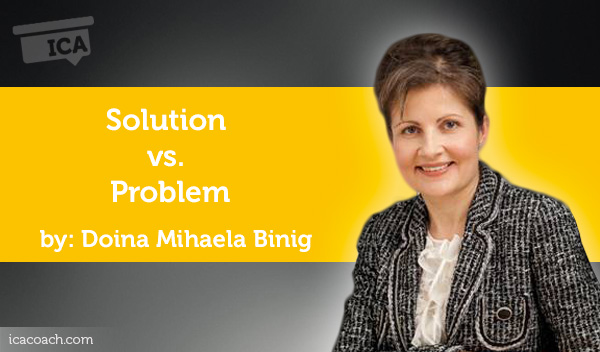A Coaching Power Tool Created by Doina Mihaela Binig
(Transformational Coach, ROMANIA)
What we pay attention to, and how we pay attention, determines the content and quality of life–Mihaly Csikszentmihalyi
Problem: A situation that is unsatisfactory and causes difficulties for people
Solution: A way of dealing with a difficult situation so the difficulty is removed
Whenever we go in a conversation with someone about a specific unpleasant situation or an issue, we have the natural tendency to focus on problems; an example of this is every time when we ask questions with the word “why” in it…
- Why do you think this happened?
- Why did you do this thing?
- Why didn’t you achieve your targets?
Focusing on problems leads us to the past, to blame, excuses and justifications. Past can’t be changed; instead, we have to focus on the way forward. We open up to new ideas and new possibilities.
If we want people to come up with great ideas, to think well, to reach their potential, we want them focused on solutions.
This is a way to address problems by analyzing the way forward instead of the causes.. This process creates energy rather than spending it.
This can be illustrated by asking the above questions in a much re-framed manner:
- What do you want to achieve here?
- What would you like to change?
- What are the key things you need to do?
- What do you need to do next time to achieve your targets?
When dealing with a “doing” situation, the approach could be more obvious.
The state of “doing” is outward looking and involves taking action. When it comes to a “being”
situation, to try to change internal habits, focusing on solutions turns out to be even more
important.
The state of “being” is inward looking and involves awareness, reflection and thinking about
things that happen.
The problem here is that if we think our problems reside inside ourselves, there is a huge difficulty to change this way of thinking. Instead, in order to improve, we must focus on new habits we’d like to develop and build a realistic plan to make these habits a part of our lives. Solution focus: “It is often easier to start something new than to stop something. Anything that is a habit is by definition difficult to stop. And, if change is encouraged by positive reinforcement, it is much easier to be aware of when you are taking the reinforceable action than to know when you are not doing whatever it is that you want to give up” “Being” solution focused means taking responsibility for outcomes and action; it requires discipline.
So, instead of asking:
- Why do you think you are a bad/ weak person?
- Why are you upset?
- Why do you feel unsecure?
We could help the client in the “being” situation, make them discover new habits and
behaviors; questions to be asked:
- Who is the perfect you?
- What steps can you take to become the perfect you?
- What can you do to feel better?
- What will your new thoughts will look like?
- What brings you joy?
- What support structures can help you become more secure?
- Can you visualize how being happy looks like for you?
Focusing on the problem can create a disempowering state, whereas moving forward can be an empowering experience.
We may need to solve problems not by removing the cause but by designing the way forward even if the cause remains in place- Edward de Bono
Bibliography:
David Rock – Quiet Leadership, Six steps to transforming performance at work
Paul Z. Jackson and Mark McKergow- The Solutions focus: The Simple way to positive change
Collins Dictionary
